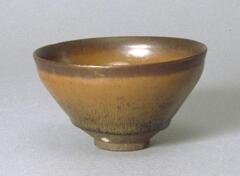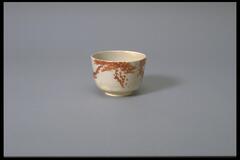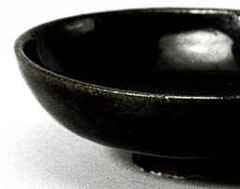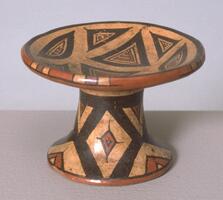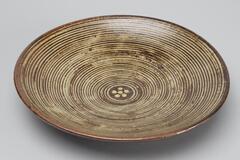11 Items in this Learning Collection
Collection Object
Collection Object
Collection Object
Collection Object
Collection Object
Collection Object
Collection Object
Collection Object
Copyright
All Rights Reserved
()
Tea Bowl, ido chawan type
Accession Number
1954/1.539
Title
Tea Bowl, ido chawan type
Artist(s)
Japanese
Artist Nationality
Japanese (culture or style)
Object Creation Date
17th century
Medium & Support
stoneware with clear glaze
Dimensions
3 1/2 in. x 5 1/4 in. x 5 1/4 in. ( 8.9 cm x 13.3 cm x 13.3 cm )
Credit Line
Bequest of Margaret Watson Parker
Label copy
During the Momoyama period (1583-1615), Japanese tea masters discovered the rustic earthenware rice bowls that were in widespread use among Korean peasant farmers. These simple bowls, along with Japanese folk items such as baskets and water basins, fit perfectly their taste for rusticity and simplicity--known as the wabi aesthetic. When many Japanese warlords, who were fervent tea practitioners themselves, went to Korea with the successive invasion attempts of Toyotomi Hideyoshi (1537-1598) in the 1590s, many ido chawan or "well-side tea bowls" were carried home and treasured as family heirlooms. Korean potters were also relocated to Japan as part of the spoils of war, and their descenddants at the Hagi clan kilns in western Japan continued to make wares that recall the ido type.
In the final decade of sixteenth century, Japanese forces under orders from the warlord Toyotomi Hideyoshi invaded Korea, in what would be a disastrous attempt to conquer China. While there, they discovered the rustic earthenware rice bowls that were in widespread use among peasant farmers. The Japanese generals, who were all schooled in tea, recognized that these simple bowls fit perfectly the criteria for “found art” espoused by the influential tea master Sen no Rikyû. The ido chawan or “well-side tea bowls” they bought home would be treasured as family heirlooms. Korean potters were also brought to Japan as part of the spoils of war, and their descendants at the Hagi clan kilns in western Japan continued to make a ware that recalls the ido type.
---
Hagi ware tea bowl, ido chawan type
Japan, Edo period
(1615–1868)
17th century
Stoneware with clear glaze
Bequest of Margaret Watson Parker, 1954/1.539
During the Momoyama period (1583–1615), Japanese tea masters discovered the rustic earthenware rice bowls that were in widespread use among Korean peasant farmers. These simple bowls, along with Japanese folk items such as baskets and water basins, fit perfectly their taste for rusticity and simplicity—known as the wabi aesthetic. When many Japanese warlords, who were fervent tea practitioners themselves, went to Korea with the successive invasion attempts of Toyotomi Hideyoshi (1537–98) in the 1590s, many ido chawan, or “well-side tea bowls,” were carried home and treasured as family heirlooms. Korean potters were also relocated to Japan as part of the spoils of war, and their descendants at the Hagi clan kilns in western Japan continued to make wares that recall the ido type.
(6/28/10)
Subject matter
During the rise of wabi aesthetics in Momoyama period (1583-1615), Japanese tea masters discovered the rustic earthenware rice bowls that were in widespread use among Korean peasant farmers. These simple bowls fit perfectly the wabi aesthetic taste for rusticity and simplicity. When many Japanese warlords, who were fervent tea practitioners themselves, went to Korea with the invasion attempts of Toyotomi Hideyoshi (1537-1598) in the 1590s, many ido chawan or “well-side tea bowls” were carried home and treasured as family heirlooms. Korean potters were also relocated to Japan as part of the spoils of war, and their descendants at the Hagi clan kilns in western Japan continued to make a ware that recalls the ido type.
Physical Description
This rustic looking bowl has a circular base from which the rounded shape of the bowl extends. The clear glaze reveals the brown and black tones of the materials.
Primary Object Classification
Ceramic
Primary Object Type
tea bowl
Collection Area
Asian
Rights
If you are interested in using an image for a publication, please visit http://umma.umich.edu/request-image for more information and to fill out the online Image Rights and Reproductions Request Form.
Keywords
bowls (vessels)
ceramics (object genre)
1954/1.539
Title
Tea Bowl, ido chawan type
Artist(s)
Japanese
Artist Nationality
Japanese (culture or style)
Object Creation Date
17th century
Medium & Support
stoneware with clear glaze
Dimensions
3 1/2 in. x 5 1/4 in. x 5 1/4 in. ( 8.9 cm x 13.3 cm x 13.3 cm )
Credit Line
Bequest of Margaret Watson Parker
Label copy
During the Momoyama period (1583-1615), Japanese tea masters discovered the rustic earthenware rice bowls that were in widespread use among Korean peasant farmers. These simple bowls, along with Japanese folk items such as baskets and water basins, fit perfectly their taste for rusticity and simplicity--known as the wabi aesthetic. When many Japanese warlords, who were fervent tea practitioners themselves, went to Korea with the successive invasion attempts of Toyotomi Hideyoshi (1537-1598) in the 1590s, many ido chawan or "well-side tea bowls" were carried home and treasured as family heirlooms. Korean potters were also relocated to Japan as part of the spoils of war, and their descenddants at the Hagi clan kilns in western Japan continued to make wares that recall the ido type.
In the final decade of sixteenth century, Japanese forces under orders from the warlord Toyotomi Hideyoshi invaded Korea, in what would be a disastrous attempt to conquer China. While there, they discovered the rustic earthenware rice bowls that were in widespread use among peasant farmers. The Japanese generals, who were all schooled in tea, recognized that these simple bowls fit perfectly the criteria for “found art” espoused by the influential tea master Sen no Rikyû. The ido chawan or “well-side tea bowls” they bought home would be treasured as family heirlooms. Korean potters were also brought to Japan as part of the spoils of war, and their descendants at the Hagi clan kilns in western Japan continued to make a ware that recalls the ido type.
---
Hagi ware tea bowl, ido chawan type
Japan, Edo period
(1615–1868)
17th century
Stoneware with clear glaze
Bequest of Margaret Watson Parker, 1954/1.539
During the Momoyama period (1583–1615), Japanese tea masters discovered the rustic earthenware rice bowls that were in widespread use among Korean peasant farmers. These simple bowls, along with Japanese folk items such as baskets and water basins, fit perfectly their taste for rusticity and simplicity—known as the wabi aesthetic. When many Japanese warlords, who were fervent tea practitioners themselves, went to Korea with the successive invasion attempts of Toyotomi Hideyoshi (1537–98) in the 1590s, many ido chawan, or “well-side tea bowls,” were carried home and treasured as family heirlooms. Korean potters were also relocated to Japan as part of the spoils of war, and their descendants at the Hagi clan kilns in western Japan continued to make wares that recall the ido type.
(6/28/10)
Subject matter
During the rise of wabi aesthetics in Momoyama period (1583-1615), Japanese tea masters discovered the rustic earthenware rice bowls that were in widespread use among Korean peasant farmers. These simple bowls fit perfectly the wabi aesthetic taste for rusticity and simplicity. When many Japanese warlords, who were fervent tea practitioners themselves, went to Korea with the invasion attempts of Toyotomi Hideyoshi (1537-1598) in the 1590s, many ido chawan or “well-side tea bowls” were carried home and treasured as family heirlooms. Korean potters were also relocated to Japan as part of the spoils of war, and their descendants at the Hagi clan kilns in western Japan continued to make a ware that recalls the ido type.
Physical Description
This rustic looking bowl has a circular base from which the rounded shape of the bowl extends. The clear glaze reveals the brown and black tones of the materials.
Primary Object Classification
Ceramic
Primary Object Type
tea bowl
Collection Area
Asian
Rights
If you are interested in using an image for a publication, please visit http://umma.umich.edu/request-image for more information and to fill out the online Image Rights and Reproductions Request Form.
Keywords
bowls (vessels)
ceramics (object genre)
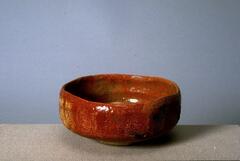

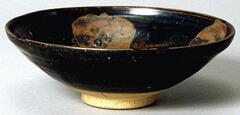
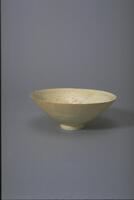
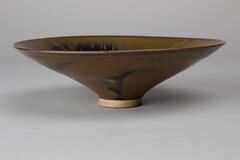
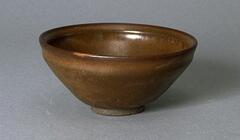

![It has a flared mouth. The side is tapering gently down to the base. It was brushed with white slip interior and outerior sides.<br />
<br />
Bowls of this kind were commonly used as burial accessories in the 15th century Joseon; many have been excavated. This bowl has been rapidly spun and brush-painted with white slip on its inner and outer surfaces. The large amount of sand mixed with the clay has produced a rough texture. Traces of clay supports remain on both the inner base and the rim of foot, indicating that this bowl was stacked among other bowls while separated by clay spurs during firing. The glaze was fused well, producing a glossy surface.<br />
[Korean Collection, University of Michigan Museum of Art (2014) p.155] It has a flared mouth. The side is tapering gently down to the base. It was brushed with white slip interior and outerior sides.<br />
<br />
Bowls of this kind were commonly used as burial accessories in the 15th century Joseon; many have been excavated. This bowl has been rapidly spun and brush-painted with white slip on its inner and outer surfaces. The large amount of sand mixed with the clay has produced a rough texture. Traces of clay supports remain on both the inner base and the rim of foot, indicating that this bowl was stacked among other bowls while separated by clay spurs during firing. The glaze was fused well, producing a glossy surface.<br />
[Korean Collection, University of Michigan Museum of Art (2014) p.155]](/media/W1siZiIsIjIwMjIvMDUvMjUvN2wwZnA4dXE4NV9kZWZhdWx0LmpwZyJdLFsicCIsInRodW1iIiwiMjQweDIwMCJdXQ?sha=8feb467e9a78db04)
![It has large-mouth and the wall slants toward the bottom in an almost straight line. It was deformed during firing.<br />
<br />
The inner and outer surfaces of this bowl are brushed with white slip. Traces of refractory spurs remain in five places on the inner base and the foot. The foot is glazed on the rim as well. This is a low-grade object with many iron-brown spots on both its inner and outer surfaces. A note from collector is adhered to the reverse side of the bowl, and it reads, “19629, corée, Hakéme,” “朝鮮刷毛目, 三百年.”<br />
[Korean Collection, University of Michigan Museum of Art (2014) p.156] It has large-mouth and the wall slants toward the bottom in an almost straight line. It was deformed during firing.<br />
<br />
The inner and outer surfaces of this bowl are brushed with white slip. Traces of refractory spurs remain in five places on the inner base and the foot. The foot is glazed on the rim as well. This is a low-grade object with many iron-brown spots on both its inner and outer surfaces. A note from collector is adhered to the reverse side of the bowl, and it reads, “19629, corée, Hakéme,” “朝鮮刷毛目, 三百年.”<br />
[Korean Collection, University of Michigan Museum of Art (2014) p.156]](/media/W1siZiIsIjIwMjIvMDUvMjUvOGwxcWg2N25pdF9kZWZhdWx0LmpwZyJdLFsicCIsInRodW1iIiwiMjQweDIwMCJdXQ?sha=35d40b809bdc1c1f)
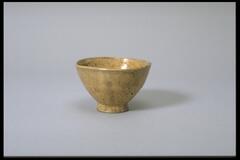
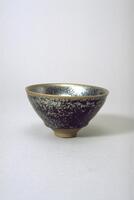
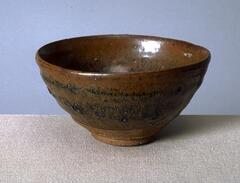
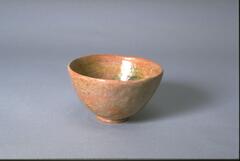
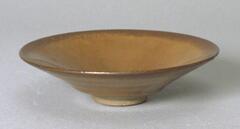
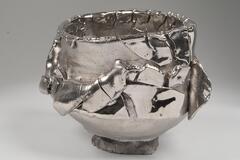
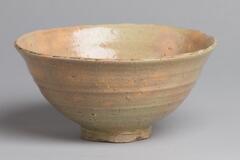
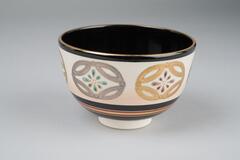
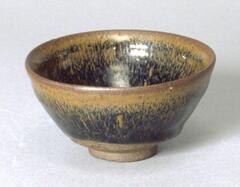
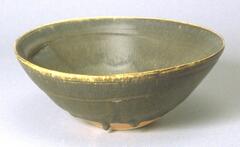

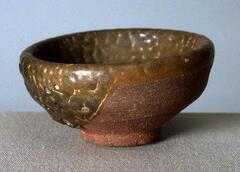
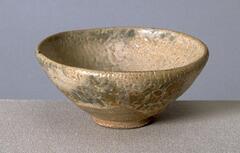
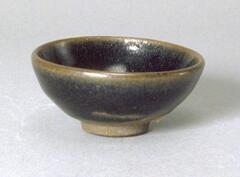
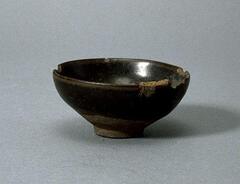
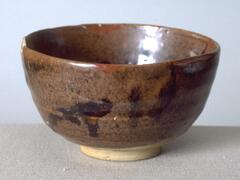
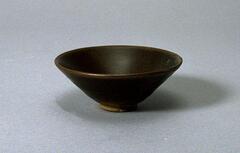
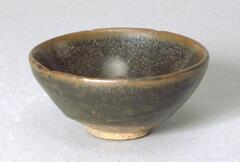

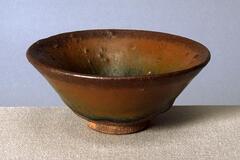
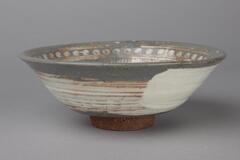
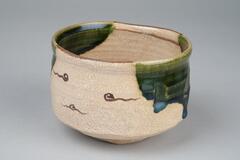
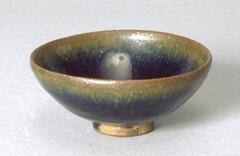


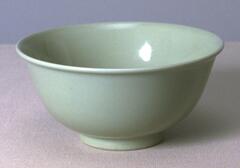

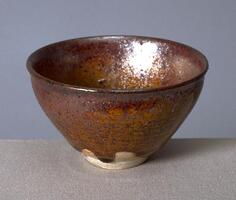
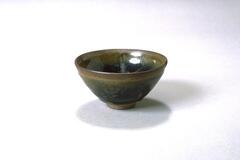

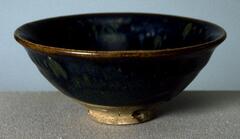
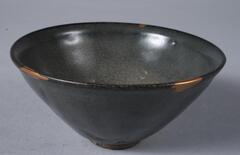
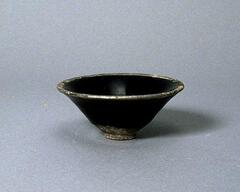
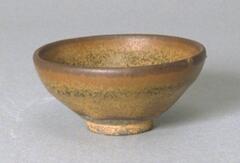
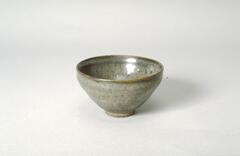

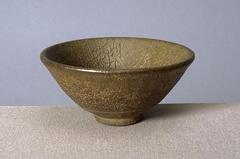
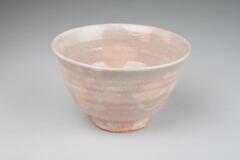
![Stoneware bowl with stamped rope-curtain design covered by a white slip and colorless glaze. A stylized inlaid chrysanthemum blossom decorates the center of the bowl, surrounded by a band of petals.<br />
<br />
This buncheong bowl with stamped design was maily supplied to government offices in the 15th century. It is decorated with a lotus flower on the inner base surrounded by lotus petals, butterflies and rows of dots on the inner wall. The outer wall, too, is filled with rows of dots. It was poorly sintered and the glaze applied to the lower part of the body is not melted in parts. The foot is not glazed and exposes the clay body.<br />
[Korean Collection, University of Michigan Museum of Art (2014) p.147] Stoneware bowl with stamped rope-curtain design covered by a white slip and colorless glaze. A stylized inlaid chrysanthemum blossom decorates the center of the bowl, surrounded by a band of petals.<br />
<br />
This buncheong bowl with stamped design was maily supplied to government offices in the 15th century. It is decorated with a lotus flower on the inner base surrounded by lotus petals, butterflies and rows of dots on the inner wall. The outer wall, too, is filled with rows of dots. It was poorly sintered and the glaze applied to the lower part of the body is not melted in parts. The foot is not glazed and exposes the clay body.<br />
[Korean Collection, University of Michigan Museum of Art (2014) p.147]](/media/W1siZiIsIjIwMjIvMDkvMjQvOWRtNDIyZTcyX2RlZmF1bHQuanBnIl0sWyJwIiwidGh1bWIiLCIyNDB4MjAwIl1d?sha=0b90e10dcc5f13d1)

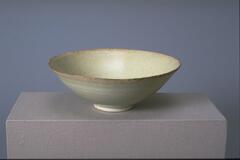
![<p>This is an undecorated bowl with diagonally flaring out sides. On the outer base and rim of the foot remain traces of refractory spur marks. The bowl was oxidized in the kiln, producing a green-brown hue, while the interior contains large bubbles. The color of its glaze is similar to that of other vessels excavated from sedimentary layers of refuse pile at celadon kilns in Goyang-si, Gyeonggi-do.<br />
[<em>Korean Collection, University of Michigan Museum of Art </em>(2014) p.101]</p>
<br />
It has an outwardly flared rim and steep side. A yellow brownish glaze is applied. The clay contains some impurities and the foot is relatively high. There is four spur-marks on the interior. <p>This is an undecorated bowl with diagonally flaring out sides. On the outer base and rim of the foot remain traces of refractory spur marks. The bowl was oxidized in the kiln, producing a green-brown hue, while the interior contains large bubbles. The color of its glaze is similar to that of other vessels excavated from sedimentary layers of refuse pile at celadon kilns in Goyang-si, Gyeonggi-do.<br />
[<em>Korean Collection, University of Michigan Museum of Art </em>(2014) p.101]</p>
<br />
It has an outwardly flared rim and steep side. A yellow brownish glaze is applied. The clay contains some impurities and the foot is relatively high. There is four spur-marks on the interior.](/media/W1siZiIsIjIwMjIvMDUvMjUvMnhtbDducjBocl9kZWZhdWx0LmpwZyJdLFsicCIsInRodW1iIiwiMjQweDIwMCJdXQ?sha=ab0ce1dba1be4d21)
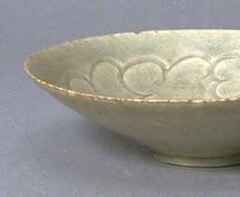
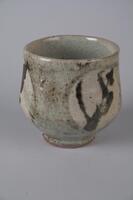
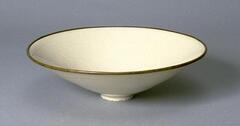
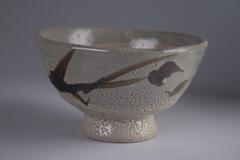
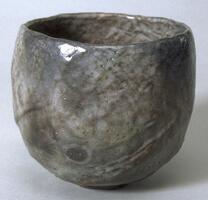
![Stoneware tea bowl with slightly flaring lip, white slip hakame design and colorless glaze.<br />
<br />
The inner and outer surfaces of this buncheong bowl have been brushed with white slip. Its inner base retains traces of seven spurs, while the uneven application of glaze has exposed the unglazed body. The glaze itself was fairly well fused. The bowl is intact without damage.<br />
[Korean Collection, University of Michigan Museum of Art (2014) p.156] Stoneware tea bowl with slightly flaring lip, white slip hakame design and colorless glaze.<br />
<br />
The inner and outer surfaces of this buncheong bowl have been brushed with white slip. Its inner base retains traces of seven spurs, while the uneven application of glaze has exposed the unglazed body. The glaze itself was fairly well fused. The bowl is intact without damage.<br />
[Korean Collection, University of Michigan Museum of Art (2014) p.156]](/media/W1siZiIsIjIwMjIvMDkvMjQvNm9xY20waHdlX2RlZmF1bHQuanBnIl0sWyJwIiwidGh1bWIiLCIyNDB4MjAwIl1d?sha=36b91ee5facf512c)
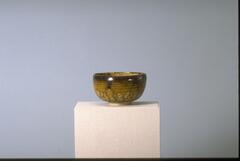
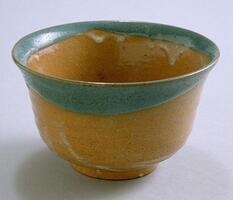




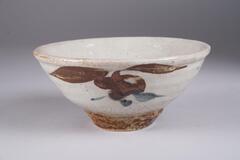
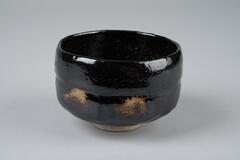
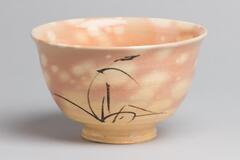

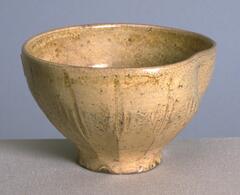
![<p>This bowl exemplifies early-tenth century celadon forms influenced by Chinese Yue ware. It has a halo-shaped foot (haemurigup), a characteristic of Yue ware. It is a high-quality celadon made from fine clay, coated by highly transparent glaze. Surface is plain while displaying crackles on its inner surface and parts of its outer surface. Many similar vessels were excavated from the Kilns no. 9 and no. 10 at Yongun-ri, Gangjin-gun, Jeollanam-do. Refractory spur marks created during firing remain in five places on the rim of the foot.<br />
[<i>Korean Collection, University of Michigan Museum of Art </i>(2014) p.88]</p>
Stoneware tea bowl with celadon glaze. <p>This bowl exemplifies early-tenth century celadon forms influenced by Chinese Yue ware. It has a halo-shaped foot (haemurigup), a characteristic of Yue ware. It is a high-quality celadon made from fine clay, coated by highly transparent glaze. Surface is plain while displaying crackles on its inner surface and parts of its outer surface. Many similar vessels were excavated from the Kilns no. 9 and no. 10 at Yongun-ri, Gangjin-gun, Jeollanam-do. Refractory spur marks created during firing remain in five places on the rim of the foot.<br />
[<i>Korean Collection, University of Michigan Museum of Art </i>(2014) p.88]</p>
Stoneware tea bowl with celadon glaze.](/media/W1siZiIsIjIwMjIvMDkvMjQvMXB2aXlzcnZpZF9kZWZhdWx0LmpwZyJdLFsicCIsInRodW1iIiwiMjQweDIwMCJdXQ?sha=7ddc9c1585910d07)

